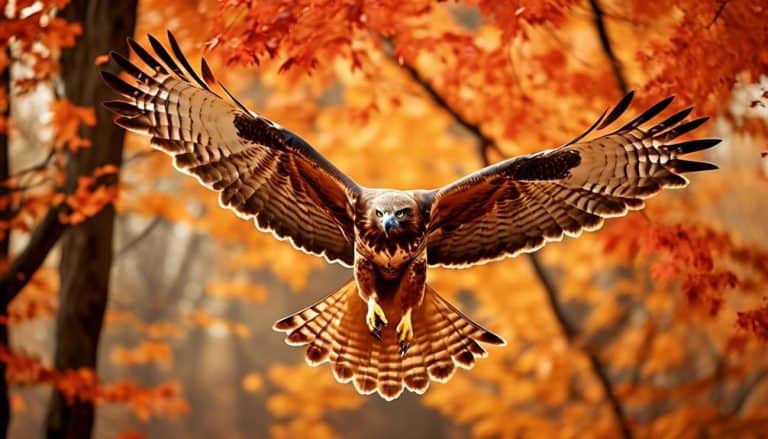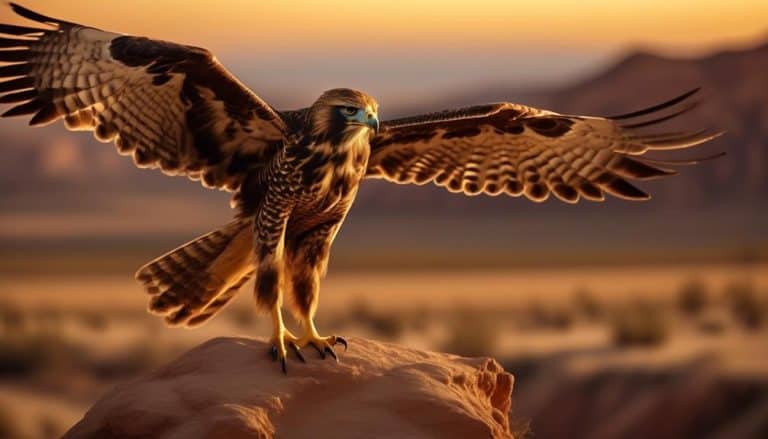Montana's avian predators possess a captivating allure, drawing admiration from those who appreciate the intricate balance of nature. These majestic creatures, with their keen eyesight and razor-sharp talons, demonstrate a remarkable ability to thrive in the vast landscapes of the Big Sky State.
From the iconic Bald Eagle, symbolizing strength and resilience, to the lightning-fast Peregrine Falcon, these birds of prey hold a prominent place in Montana's ecosystem. As we explore the diverse species that call this rugged terrain home, we will uncover the unique characteristics and fascinating behaviors that make them true masters of the sky.
The Bald Eagle: Montana's Iconic Predator
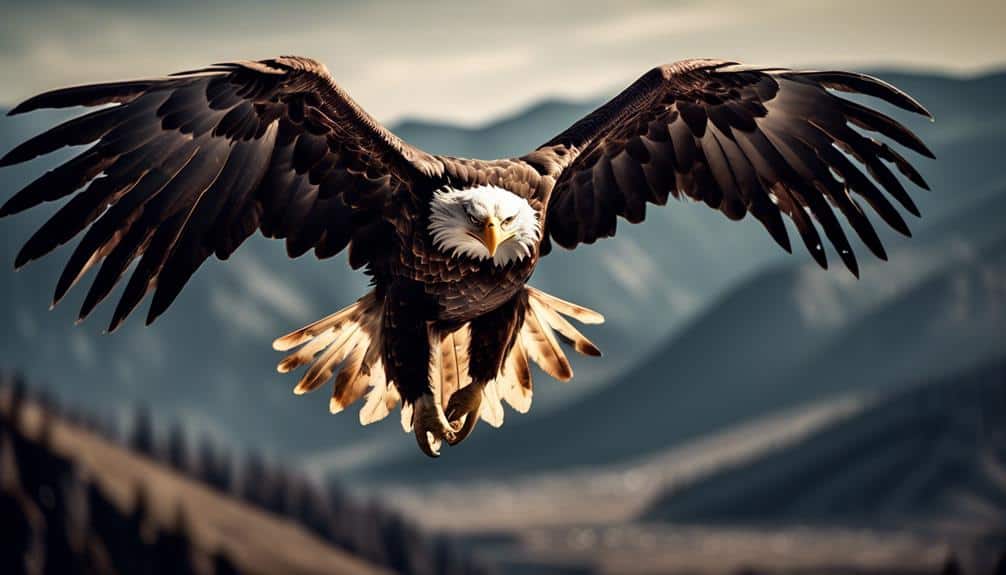
The Bald Eagle, a majestic and formidable predator, plays a vital role in Montana's ecosystems as an apex predator and symbol of strength and resilience. Conservation efforts have focused on protecting the species and its nesting habitats, ensuring its continued presence in the state.
The bald eagle's nesting habits are fascinating and unique. Bald eagles typically build their nests, known as aeries, in tall trees near bodies of water, such as lakes or rivers. These nests are large structures made of sticks, twigs, and other materials, often measuring several feet in diameter. The female eagle lays one to three eggs each year, which are incubated for about 35 days. Both parents take turns incubating the eggs and caring for the chicks once they hatch.
Conserving bald eagle nesting habitats is crucial for their population's survival. Protection measures include establishing wildlife refuges, limiting disturbance near nest sites, and enforcing regulations against habitat destruction. By safeguarding these nesting areas, we can ensure the continued success of bald eagles in Montana's ecosystems.
The bald eagle's nesting habits provide valuable insights into their life cycle and behavior. By understanding and preserving these habitats, we can contribute to the long-term conservation of this iconic predator and symbol of resilience in Montana.
The Peregrine Falcon: Master of Speed and Agility

With its remarkable speed and agility, the Peregrine Falcon is a true master of the skies. This magnificent bird of prey can reach speeds of up to 240 miles per hour during its breathtaking hunting dives, making it the fastest animal on the planet.
The Peregrine Falcon's hunting techniques are truly awe-inspiring. It uses its keen eyesight to locate its prey from great heights, then folds its wings and plummets towards its target in a spectacular dive known as a stoop. With its sharp talons and hooked beak, the falcon swiftly captures its prey, which mainly consists of small to medium-sized birds. The Peregrine Falcon's hunting efficiency is a testament to its incredible adaptability and precision.
However, the Peregrine Falcon has faced significant challenges in recent history. Due to the widespread use of pesticides, such as DDT, the falcon population suffered a severe decline in the mid-20th century. Fortunately, conservation efforts have helped to restore their numbers. Through the implementation of bans on harmful pesticides and the establishment of protected habitats, the Peregrine Falcon has made a remarkable recovery.
These conservation efforts haven't only benefited the falcon population, but also contributed to the overall health of ecosystems in which they reside.
The Red-tailed Hawk: Montana's Most Common Bird of Prey
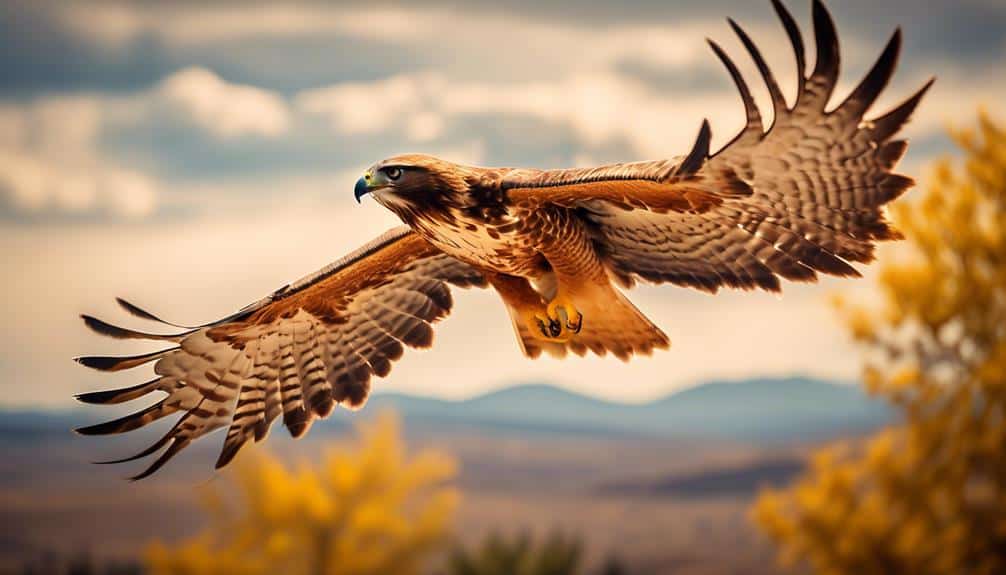
The Red-tailed Hawk, a species commonly found in Montana, is a formidable predator in the avian world. With its broad wingspan and keen eyesight, this majestic bird is well-adapted to thrive in the diverse habitats of the state.
| Red-tailed Hawk | |
|---|---|
| Scientific Name | *Buteo jamaicensis* |
| Wingspan | 4.5 to 5.5 feet |
| Weight | 2 to 4 pounds |
| Habitat | Forests, grasslands, |
| agricultural areas | |
| Behavior | Perch hunting, soaring, |
| territorial |
The Red-tailed Hawk is known for its distinctive red tail feathers, which become more vibrant as the bird matures. This species is highly adaptable and can be found in a variety of habitats, including forests, grasslands, and even agricultural areas. They are often seen perched on tree branches or utility poles, patiently scanning the surroundings for their next prey.
When it comes to hunting, the Red-tailed Hawk employs a sit-and-wait strategy. From their elevated perches, they observe the ground below, searching for small mammals, birds, and reptiles. Once a suitable target is spotted, the hawk swiftly swoops down, using its sharp talons to capture its prey.
Red-tailed Hawks are territorial birds, fiercely defending their nesting sites. They build large nests made of sticks, usually high up in trees or on cliffs. These nests are reused year after year, with the hawks adding fresh materials to reinforce the structure.
The Great Horned Owl: An Apex Nocturnal Hunter
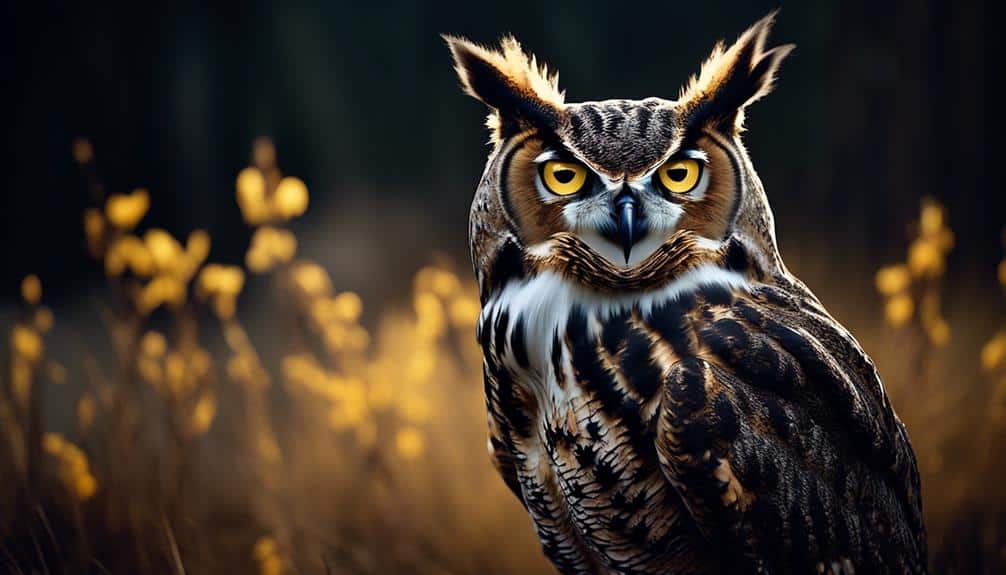
Having explored the predatory prowess of the Red-tailed Hawk, it's now time to shift our focus to the nocturnal realm and discuss the remarkable abilities of the Great Horned Owl, an apex hunter of the night. The Great Horned Owl, scientifically known as Bubo virginianus, possesses a set of unique adaptations that enable it to thrive in the darkness.
Nocturnal hunting techniques of the Great Horned Owl:
- Silent flight: The Great Horned Owl possesses specialized feathers that allow for silent flight, making it virtually undetectable to its prey. This stealthy approach gives it a significant advantage when hunting in the dark.
- Exceptional hearing: With its large, forward-facing eyes and asymmetrical ear openings, the Great Horned Owl has exceptional hearing capabilities. It can locate prey accurately by sound alone, even in complete darkness.
Habitat and range of the Great Horned Owl:
- Broad range: The Great Horned Owl is one of the most widespread owl species in North America. It can be found throughout Montana and across various habitats, from forests and deserts to suburban areas.
- Diverse habitat preferences: Although the Great Horned Owl is adaptable, it tends to favor forested areas with open spaces for hunting. It can also be found nesting in cliffs, abandoned nests, or even on the ground.
The Great Horned Owl's nocturnal hunting techniques and its ability to inhabit a diverse range of habitats make it a formidable predator of the night. Its silent flight and exceptional hearing allow it to effectively locate and capture prey, making it a true apex hunter.
The Osprey: A Fish-Eating Raptor of Montana's Waterways

The Osprey, a formidable fish-eating raptor, is a prominent avian species found along the waterways of Montana. With its distinct appearance and unique hunting techniques, the Osprey stands out among the diverse bird population in the state.
The Osprey's nesting habits are fascinating. These birds typically build their nests on elevated structures such as tall trees or man-made structures like utility poles. The nests are large and made of sticks, lined with softer materials like grass and moss. Often, Ospreys return to the same nest year after year, adding to it and repairing any damages.
When it comes to hunting, the Osprey has perfected its technique for catching fish. With its keen eyesight, it spots its prey from high above the water's surface. Once a fish is spotted, the Osprey hovers briefly before plunging into the water feet first, grabbing the fish with its sharp talons. Its reversible outer toe and spiky pads help secure the slippery catch.
To provide a visual representation, here is a table summarizing the Osprey's nesting habits and hunting techniques:
| Osprey's Nesting Habits | Osprey's Hunting Techniques |
|---|---|
| Builds nests on elevated structures | Spots fish from high above |
| Nests are made of sticks, grass, and moss | Hovers before plunging into the water |
| Often returns to the same nest year after year | Grabs fish with sharp talons |
| Adds to and repairs the nest as needed | Uses reversible outer toe and spiky pads for secure catch |
The Golden Eagle: Montana's Majestic Mountain Hunter
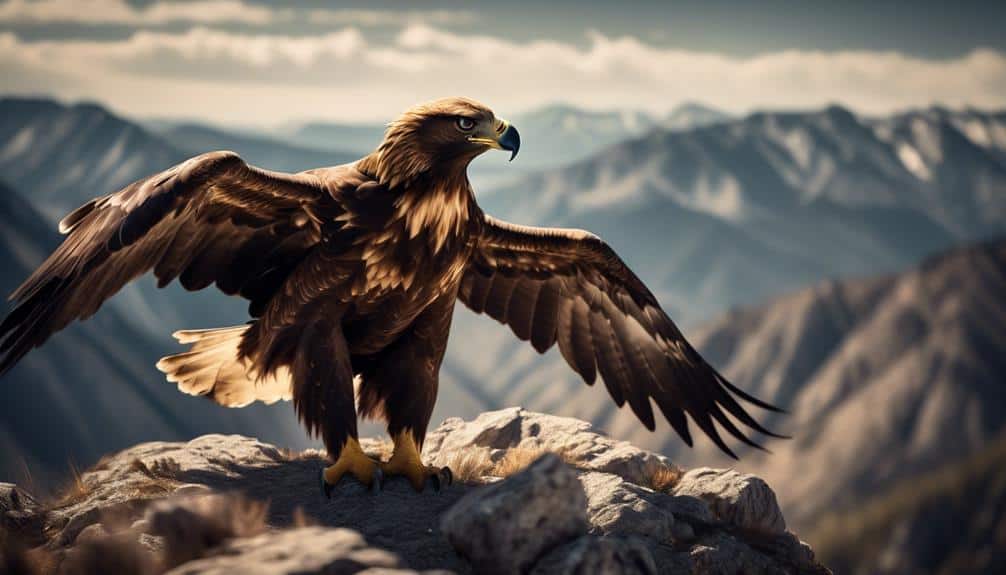
Nestled within the majestic mountains of Montana, the Golden Eagle reigns as a skilled and formidable hunter. With its impressive wingspan of up to seven feet, this majestic bird soars through the sky, scanning the landscape below for its next meal.
The golden eagle's hunting techniques are highly effective and demonstrate its adaptability as a predator. Here are some key facts about the golden eagle's hunting habits:
- Hunting Techniques:
- The golden eagle primarily hunts small to medium-sized mammals, such as rabbits, squirrels, and even prairie dogs.
- It employs a variety of hunting techniques, including soaring, perch hunting, and stooping.
- Soaring involves gliding at high altitudes, using its keen eyesight to spot potential prey from great distances.
- Perch hunting involves patiently waiting on a high vantage point, such as a tree or rock, and swooping down when an opportunity arises.
- Stooping is a rapid, high-speed dive towards prey, often reaching speeds of up to 150 miles per hour.
Nesting Habits:
- Golden eagles typically build their nests in high cliffs or tall trees, providing a secure location for raising their young.
- These nests, known as eyries, are large and constructed with branches, twigs, and other materials.
- The female eagle lays one to four eggs, with both parents taking turns incubating them.
- Once hatched, the parents tirelessly hunt and provide food for their offspring until they're ready to leave the nest.
The golden eagle's hunting techniques and nesting habits highlight its remarkable adaptability and prowess as a mountain hunter in the vast wilderness of Montana.
Frequently Asked Questions
How Many Species of Birds of Prey Are Found in Montana?
There are multiple species of birds of prey in Montana. These majestic creatures have varying average lifespans and habitat preferences. Their presence in the state contributes to the diverse and thriving ecosystem.
What Is the Average Wingspan of the Bald Eagle in Montana?
The average wingspan of the bald eagle in Montana is approximately 6 to 7 feet. This iconic species is an important part of the state's bird of prey population and conservation efforts. Climate change may impact their wingspan in the future.
How Does the Hunting Behavior of the Peregrine Falcon Differ From Other Birds of Prey in Montana?
In the realm of bird hunting, the peregrine falcon stands apart. Its unique hunting techniques and characteristics set it apart from other birds of prey.
Do Red-Tailed Hawks Migrate in and Out of Montana During Certain Seasons?
Yes, red-tailed hawks do migrate in and out of Montana during certain seasons. The migration patterns of the red-tailed hawk population are influenced by factors such as food availability and weather conditions.
How Does the Great Horned Owl Adapt to Hunting at Night in the Montana Wilderness?
I've studied how the Great Horned Owl adapts to hunting at night. Their remarkable adaptations include keen night vision, silent flight, and sharp talons. It's fascinating to observe their stealthy nocturnal hunting strategies in action.
Conclusion
In conclusion, Montana is home to a diverse array of birds of prey that play crucial roles in maintaining the ecological balance of the region.
One fascinating statistic is that the Red-tailed Hawk, Montana's most common bird of prey, has a wingspan that can reach up to 4 feet, allowing it to soar through the skies with ease and grace.
These majestic predators serve as indicators of the health of our ecosystems and remind us of the beauty and resilience of nature.


